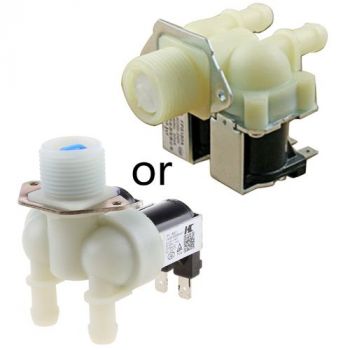Maintenace

Washing machine water inlet valves replacement in Nairobi Kenya. Washing machine repairs call 0720048519. Water inlet valve solenoids repairs.
Few home appliances are as cherished–or as heavily used–as the washing machine. Yet because of the high volumes of water which they utilize, washing machines can also be the source of potential disasters. Should a leak develop, you may find your basement or your washroom suddenly flooded. For that reason, it is important to understand why and where washer leaksand other problems occur. This article will help to expand your understanding of washing machine anatomy by discussing the role of the inlet valve, as well as the particular issues to which it is prone.
Managing Water
The inlet valve can be found on the back of your washing machine. Its principal responsibility is to manage the entry of water into your washing machine. In other words, the inlet valve acts as a sort of gate keeper, allowing water to flow into the tub when it receives certain electrical signals from the washer. There are two attachment ports on the inlet valve: one for the cold water supply hose, and one for the hot water supply hose.
Inside each of these ports is a special gate. These gates, by default, stay in the closed position. Yet when you start up a wash cycle, the machine sends a signal to the solenoid controlling a particular gate. This solenoid then triggers the gate to open so that water can enter the machine. Depending on the temperature setting you are using, either one or both of the inlet valve’s gates will be opened.
Filter Screen Problems
As you can see, an inlet valve represents a fairly complex intersection between the electrical, mechanical, and fluid components of a washing machine. As a result, it is common for inlet valves to experience problems over time. Perhaps the most commonly faced problem is that of a restricted water flow. This is not the result of improper functioning so much as it is the result of debris clogging up the inlet port.
You see, inside of each of the inlet valve’s ports is a fine mesh filter screen. Much like the filter screen on a faucet, this circular piece of metal mesh is responsible for preventing sand, minerals, and other debris from getting into your system. Over time, however, such debris will become so backed up around the filter that it will restrict the flow of water into the machine.
This may present two problems. First, it will slow the entry of water into your washer. In some cases, if the build up becomes thick enough, it may prevent water from entering the machine altogether! When this happens, pressure within the supply hoses grows. As a result, the pressure may become so great that the hose begins to leak. In the worst case scenario, the hose will rupture, sending a continual flood of water out across the floor.
Fortunately, it is fairly simple to prevent filter screen issues. A repair person simply has to shut off the water supply valves, detach the hoses from the inlet valve, and replace the water valve.
Solenoid Problems
An inlet valve may also cease to function properly due to problems with the solenoids. Like all electrical components, the solenoids have a certain lifespan. Eventually, they are liable to become overworked and burnt-out altogether. When this happens, the electrical signal being sent from the machine is unable to trigger the gates inside of the inlet valve to open.
A bad solenoid, in other words, will prevent water from entering the wash tub. To verify that a solenoid is the cause of this problem, a repair technician will verify if the solenoid is stuck closed. If that is the case, the technician will replace the entire water valve. We never attempt to disassemble a water valve, they are not designed for that to be done in the field.
If your washing machine has been displaying signs of trouble, it is important that you contact a professional as soon as possible. Please do not hesitate to reach out to the experts at Appliance Repair Nairobi Kenya on 0720048519







